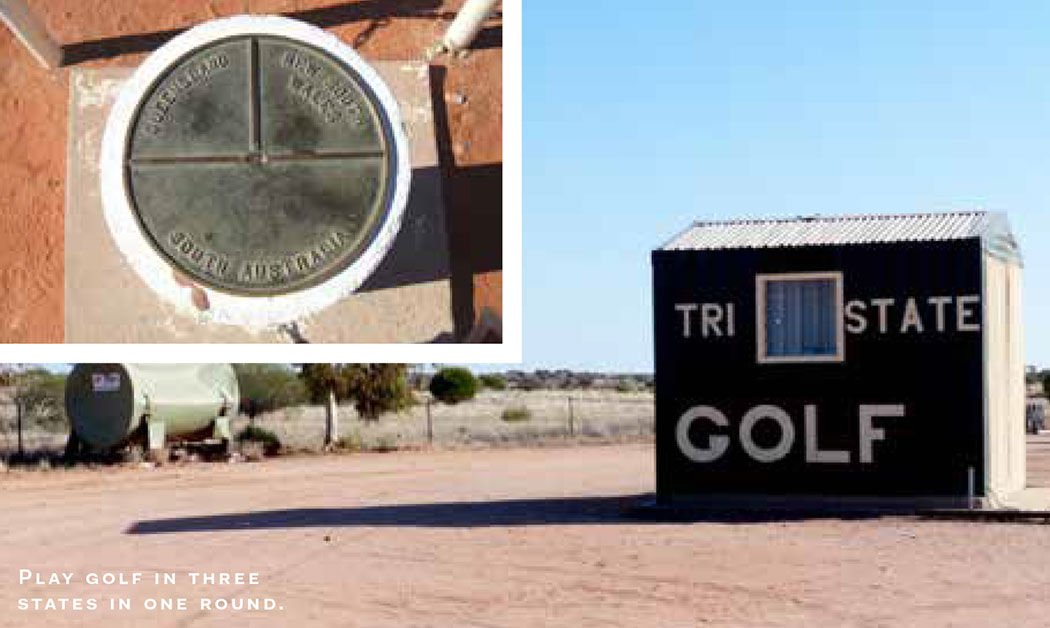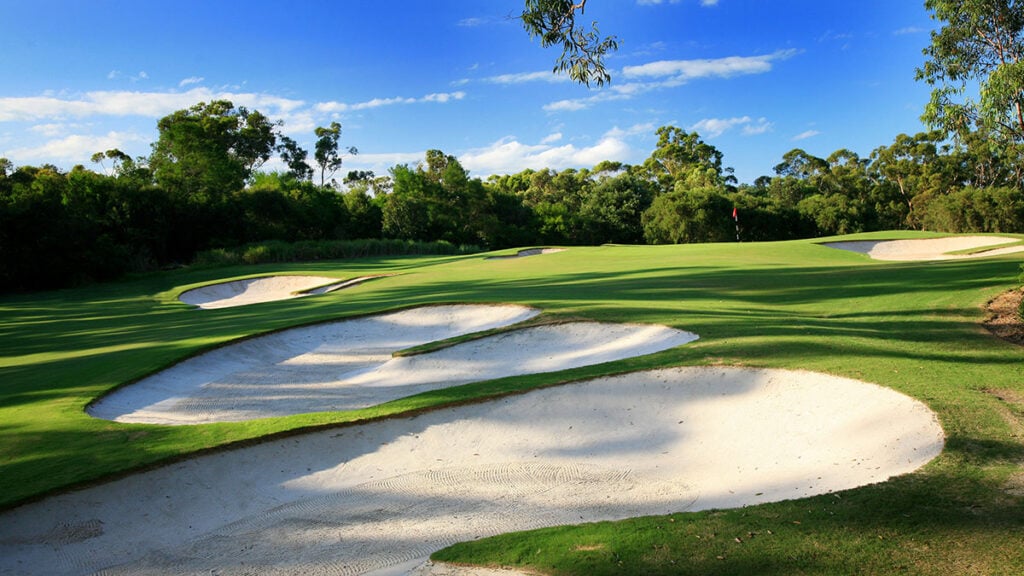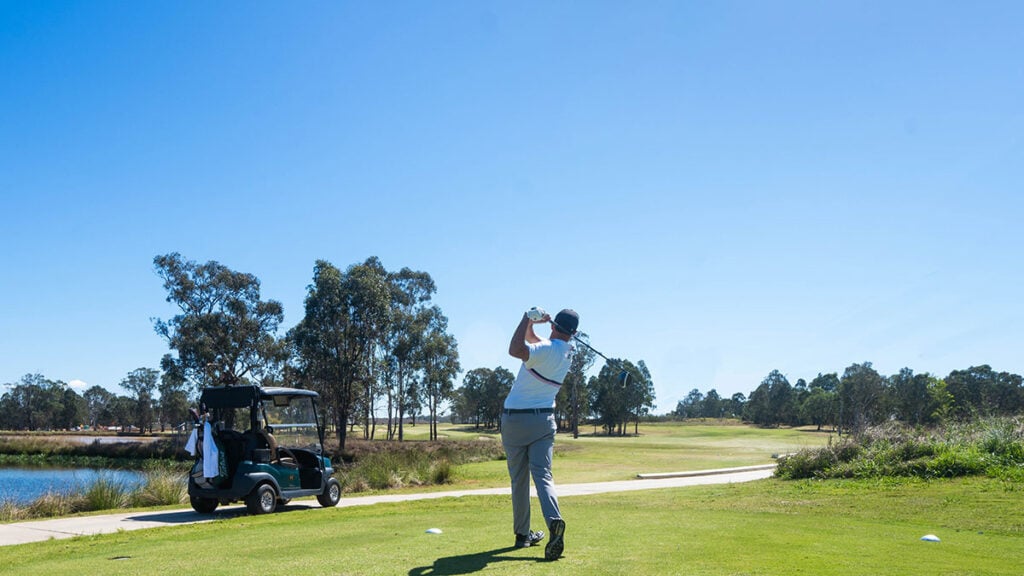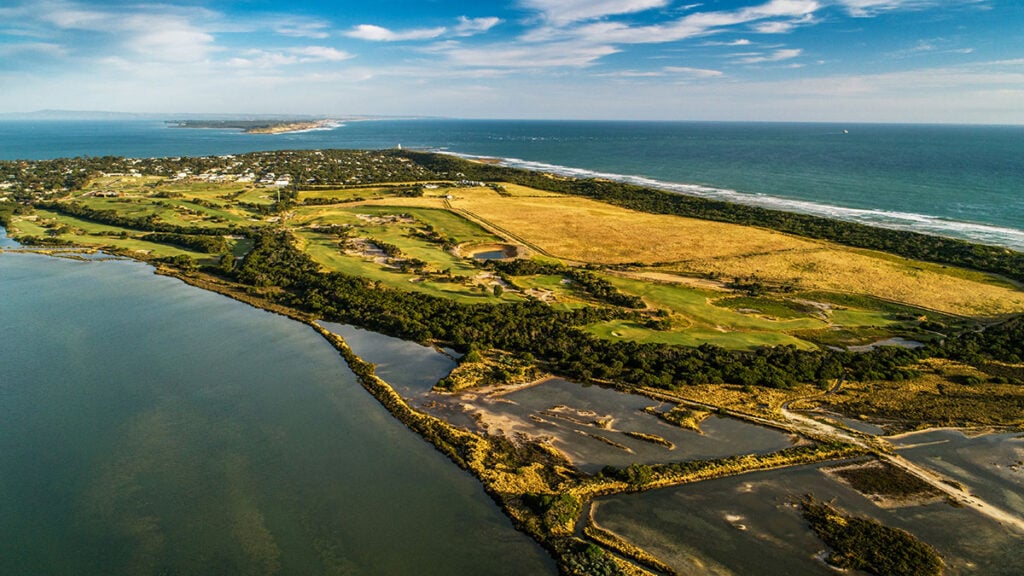Arguably golf’s most prized asset is the sheer diversity of the arenas in which we play. Tennis courts or football stadia might vary in surface and location, but they’re essentially the same dimensions wherever in the world you travel. Conversely, what sets each golf course apart is a lack of any inherent similarity.
Here’s a collection of Australian courses that offers two things. Firstly, they demonstrate the sheer breadth of golf courses across this country. Secondly, there’s simply nothing else like them. While many of these layouts won’t pique the interests of course-architecture aficionados, each owns a high ranking in another class: uniqueness.
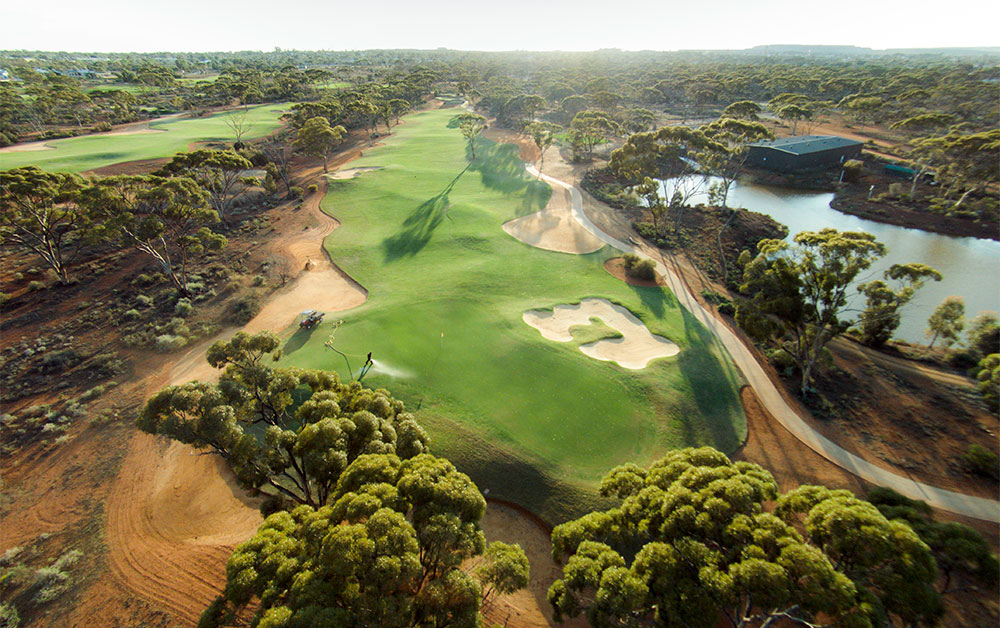
The King of Desert Golf
It’s big, it’s brawny and it’s remote but it’s also wickedly good. Kalgoorlie Golf Course – designed by the pride of Kalgoorlie, Graham Marsh – is a golf oasis in one of the most harsh and unforgiving sections of this wide, brown land. Now in its 10th year of existence and a regular stop on the PGA Tour of Australasia, the Kalgoorlie course has built a reputation as a tough challenge in a tough environment. “I distinctly recall my first design visit,” Marsh wrote for us in 2017. “As I roamed the site my mind was racing; this was my opportunity to design Australia’s first genuine desert golf course.
“With the inevitable closing of the iconic ‘Super Pit’ in the foreseeable future, a landmark that has so much defined the city’s history, just maybe the Kalgoorlie-Boulder Golf Course will be the little nugget of gold that will transcend time and prevail long after the last veins of gold-bearing ore have been extracted and processed.”
Corner Office
One mercurial Aussie course spans three states. Sitting on Cameron Corner, which is at the junction of South Australia, Queensland and New South Wales is a nine-holer known as the Tri-State Course. It won’t win any beauty pageants or plaudits for architectural genius, but the all-dirt layout has something no other course in Australia can claim: three holes in three different states.
In America, with its 50 states, such a novelty would be far more likely to discover. With a mere six states, though, and swathes of barren ‘nothingness’ along most of our borders, it’s a much more difficult feat here. Only Albury/Wodonga and the Murray River region plus Coolangatta / Tweed Heads are populous border areas in Australia, yet in those places not one course straddles even a single border, let alone two. Cameron Corner isn’t exactly on a ‘just passing by’ highway, but if you ever do find yourself there, playing golf in three states in one round is a must.
Long Links
In a similar vein is Nullarbor Links, the most spread-out golf course in the world. It’s a rare compilation layout, spanning 1,365 kilometres and cherry-picking holes from multiple courses along the Eyre Highway. Depending on which direction you’re travelling (east to west is advisable), the course begins in Ceduna, South Australia, and concludes at Kalgoorlie in Western Australia.
Bob Bongiorno, who is considered the father of the concept, saw Nullarbor Links as a way to slow people down and make the Eyre Highway crossing part of the broader journey. Thus, the project came from a desire to change how travellers perceive the vast highway, as “the majority of people crossing the Nullarbor had a racetrack mentality”.
Several of the 18 are existing holes from other courses, such as Ceduna, Eucla, Norseman and the mighty Kalgoorlie. Others are purpose-built in locations of note, such as the 160-metre sixth hole, which can be found at Border Village, just 50 metres on the SA side of the West Australian Agricultural Checkpoint. Artificial greens on some holes stand out from the red dirt in a uniquely Australian contrast.
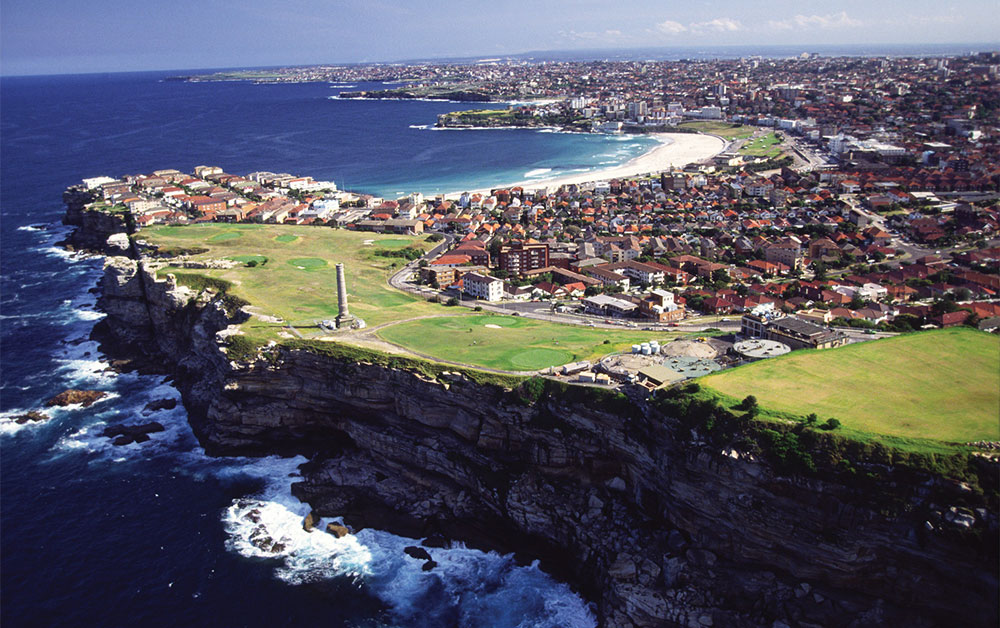
One Amazing (And Expensive) Location
Not that we’d ever advocate it, but if Bondi Golf & Diggers Club were ever sold off for real estate, only the Gina Rineharts and Malcolm Turnbulls of the world would be likely to afford it. So the fact that some of Sydney’s most prized land is instead ‘owned’ by golf – with green fees from as low as $15 – is a tremendous win within what might be the nation’s most famous suburb.
The fact that some of Sydney’s most prized land is instead “owned” by golf is a tremendous win.
Fifteen years ago the club merged with North Bondi RSL, which explains the name change. The course is elementary but fun, notable for not just its clifftop location but also for the monument in the middle of the course, which is a ventilation tower linked to the Bondi sewage treatment plant.
Compass-Point Contenders
Of Australia’s four most extreme course locations – as far as the compass is concerned – none is on the mainland and only one lies within the bounds of the geographic bulk of the country.

You could be forgiven for thinking the Byron Bay area is home to the easternmost course, but instead the Pacific Ocean golf clubs of Norfolk Island and Lord Howe Island vie for the title. And winning that battle is Norfolk Island, situated halfway between New Zealand and New Caledonia. In truth, both Lord Howe and Norfolk are worth visiting for their island views and windswept fairways (and local hospitality).

Our westernmost course lies on the Cocos (Keeling) Islands, which sit far off the north-west coast of Australia and closer to Indonesia than our mainland. The course is as you might expect in this oceanic, tropical location. It makes use of its stunning setting and palm trees are ubiquitous. (Incidentally, the distance between the golf courses on Norfolk and the Cocos Islands is a not-insignificant 7,524 kilometres – so it’s a wide blue land as well as brown.)
The distance between the golf courses on Norfolk and the Cocos Islands is a not-insignificant 7,524 kilometres.
Swapping longitude for latitude, and Christmas Island is home to the northernmost golf course in Australia, while Dover Golf Club, which is 82 kilometres south of Hobart, is our southernmost.
Where It All Began
While on the Apple Isle, why not pay homage to the oldest golf course in Australia, Ratho Farm. You may (and should) play the course with hickory clubs, opening and closing the various farm gates between holes as your mind harks back to the 1800s when golf was first played there. Six ‘lost’ holes were restored a few years ago based on maps, photographs and scorecards. For those seeking a longer stay, Ratho’s character accommodation consists of old farm buildings – a bakery, cookhouse, granary loft, stables and more – lovingly restored into boutique rooms with modern features while retaining elements of the original masonry and carpentry. Along with the nearby Australasian Golf Museum at Bothwell, the pair makes for a quintessential double act.
Island Life
Few golf courses occupy their own island. Nambucca Heads Island Golf Club on the New South Wales north coast can claim to, but the granddaddy of them all in this department is Hamilton Island Golf Club. Officially situated on Dent Island, just a short – and pleasant – boat ride from the famous resort isle, the Peter Thomson/Ross Perrett design is the best of the unique courses we’ve selected, coming in at 31st on our ranking of Australia’s Top 100 Courses.
The setting is the stuff of postcards but the golf course is equally scintillating, positioned on the high part of the island to enhance the picturesque views. The flip side to that, however, is full exposure to whatever breezes are whipping across the various Whitsundays channels. And with dense natural scrub lining almost every hole, Hamilton Island is a brute of an examination test. Still, it’s paradise, so even a little punishment doesn’t seem as bad here as back in the ‘real world’.
While island hopping, we should also mention Alyangula Golf Club on Groote Eylandt, the largest island in the Gulf of Carpentaria. The nine-hole course has 18 tees and is maintained by dedicated greenkeepers and volunteers. The beachfront journey begins after the first hole where golfers are treated to marine activity in Milner Bay, including dolphins, stingrays, schools of large pelagic fish sizing up their prey and even the odd saltwater crocodile. The par-3 third hole features one of the largest natural bunkers in the world and a typical Alyangula green, which is surrounded by tropical coconut palms.
Golfers are treated to marine activity in Milner Bay, including dolphins, stingrays, schools of large pelagic fish sizing up their prey and even
the odd saltwater crocodile.
Groote Eylandt was named by explorer Abel Tasman in 1644 and is Dutch for ‘large island’. While remote, it is easily accessible by plane from Cairns, Darwin and Gove (Nhulunbuy).
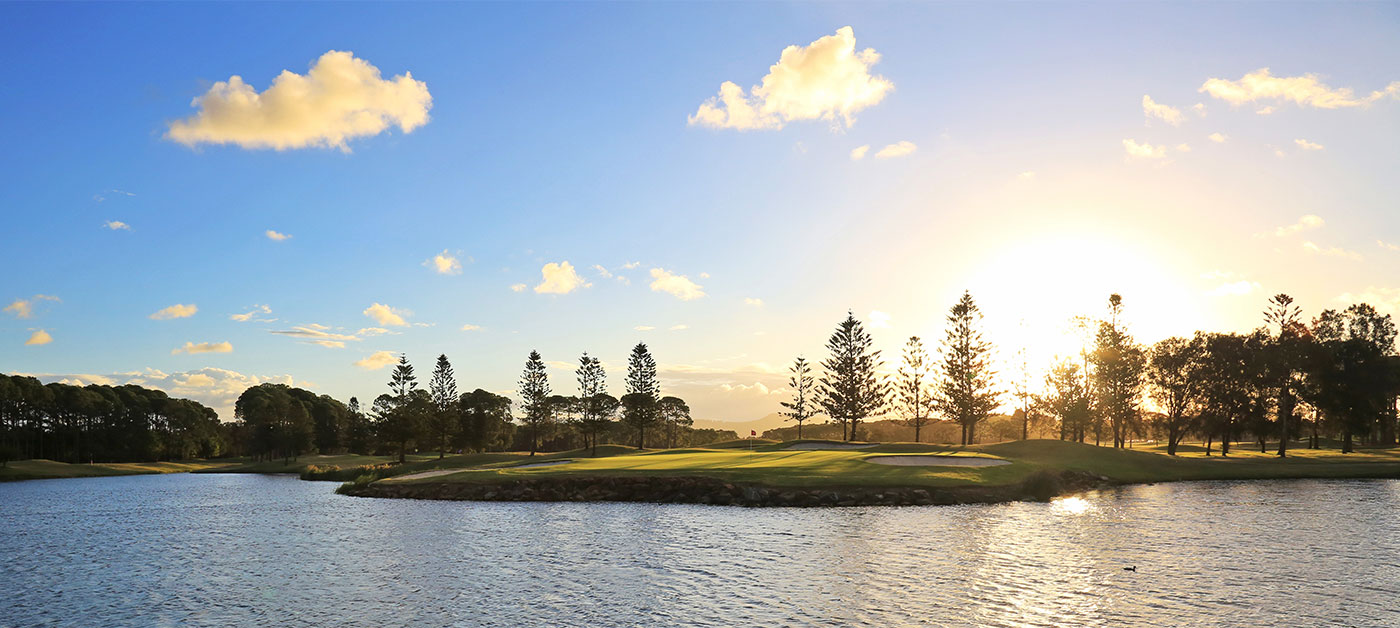
Arnie’s Legacy
Arnold Palmer meant a lot of things to a lot of golfers, however only one Australian golf club was privileged to feel his course-design touch. The lone Palmer design here is the Pines course 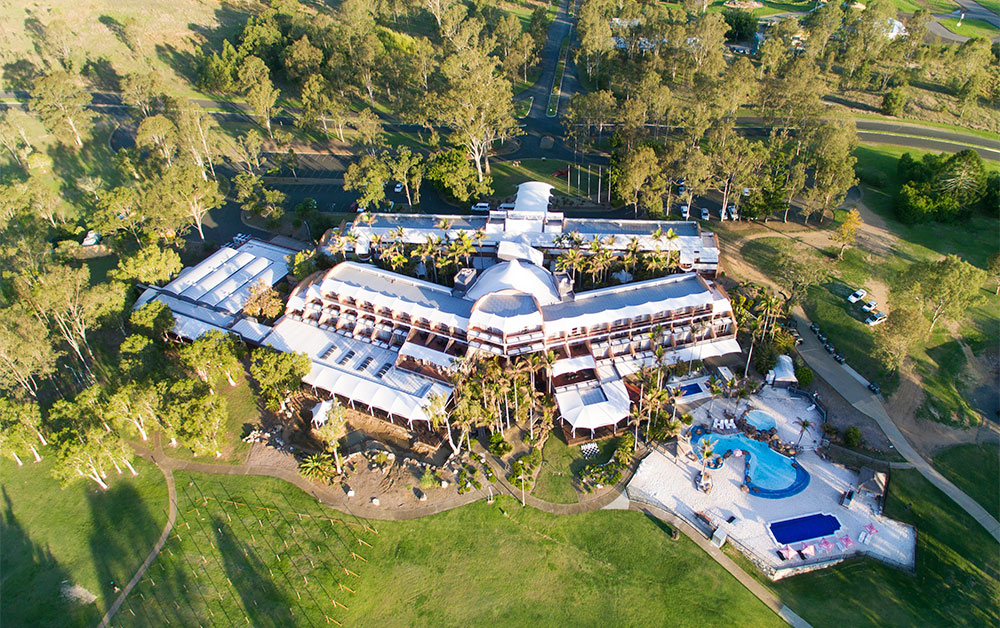 at Sanctuary Cove, which was penned in collaboration with Ed Seay. For many years regarded as the most difficult course in the country, on occasion the Pines also tested our leading touring professionals at since-defunct tournaments. Like many Gold Coast sites, the land is flat so features needed to instead come in the form of large lakes, bunkers and the eponymous pine trees.
at Sanctuary Cove, which was penned in collaboration with Ed Seay. For many years regarded as the most difficult course in the country, on occasion the Pines also tested our leading touring professionals at since-defunct tournaments. Like many Gold Coast sites, the land is flat so features needed to instead come in the form of large lakes, bunkers and the eponymous pine trees.
First-time players always remember the hero-carry 13th hole, a par three that nudges 200 metres in length from the back tee and plays almost entirely across water, plus the dogleg 18th, which wraps left around another lake and is as demanding a finishing hole as you’re ever likely to encounter.
Proof That Courses Can Come Back From The Dead
Elsewhere on the Gold Coast is a heartening story in an era when seemingly more courses close than open. Kooralbyn Valley began operation in October 1979 and just two years later was chosen to host the 1981 Queensland Open. The first golf resort built in Australia with Greg Norman as its touring professional at the time, Kooralbyn is renowned Scottish course designer Desmond Muirhead at his best. The 220-metre par-3 fifth hole, which drops more than 30 metres from tee to green, was one of a handful of showstoppers during a round.

After eight years in the wilderness during the global financial crisis, Peter Huang, founder of the Yong Real Estate group, purchased and re-opened the golf course and adjoining resort in 2016. Course manager Jeremy Parry, designer Marcus Lane from Atlas Golf and course shaper Lindsey Richter set about redesigning and rebuilding all 18 greens. Additionally, the bunkers were reshaped and refurbished with pure white sand and a new irrigation system installed. After the multi-million-dollar makeover, the course is impressing once again.
Kooralbyn is the Aboriginal name of ‘copperhead’. Famous for its Copperhead Challenge, the inland course with contrasting nines is accessible from Brisbane and the Gold Coast. The front nine winds through natural valleys and watercourses, while the back flirts with 10 hectares of lakes in the valley basin. Wildlife is abundant, with hundreds of kangaroos feeding on a daily basis. Golf doesn’t get much more uniquely Australian than that.

